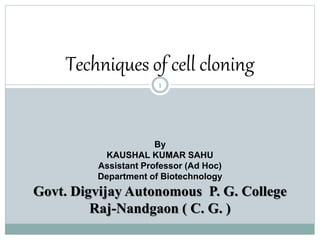
Techniques of cell cloning
- 1. Techniques of cell cloning 1 By KAUSHAL KUMAR SAHU Assistant Professor (Ad Hoc) Department of Biotechnology Govt. Digvijay Autonomous P. G. College Raj-Nandgaon ( C. G. )
- 2. ROADMAP Introduction What is cloning? Why we want to do cloning? History Technique of cell cloning Dolly – the sheep Species cloned Why persue animal cloning research? Conclusion 2
- 3. Introduction Clones are organisms that are exact genetic copies. Cloning is to duplicate a cell or an organism, usually asexually which is genetically an exact replica of the other cell or organism. 3
- 4. What is cloning? 4 The process of making identical genomic copies of an organism. Production of one or more individual plants or animals that are genetically identical.
- 5. Why we want to do cloning? 5 Researchers hope that these techniques can be used in researching and treating human disease and genetically altering animals for the production of human transplant organs .
- 6. History 6 1963 – J.B.S Haldane coined the term clone which is derived from the greek word klwn meaning twig. 1978 – 1st baby conceived through invitro fertilization is born in england. 1994 – Dr. Neal of wisconsin university clone calves from embryos that had grown to 120 cells. 1996 – Dolly is born at roslin institute.
- 7. Technique of cell cloning 7 There are two approaches -: 1) Monolayer culture – A type of culture in which cells are grown in a single layer on a flask or petri dish containing the culture medium. 2) Suspension culture – It is a type of culture in which single cells or small aggregates of cells multiply while suspended in agitated liquid medium.
- 8. 8 Dilution cloning – It is the most commonly used technique for cloning of monolayer cells and involves following stages. 1) Trypsinization of cells to produce single cell suspension. 2) Dilution of cells to about 10-100 cells/ml. 3) Seed the cells in multiwell dishes, petriplates or plastic bottles. 4) Incubate under appropriate conditions for 1-3 weeks. 5) Isolate individual colonies.
- 9. 9
- 10. 10 Suspension cloning - The technique of cloning in agar suspension is carried out in the following stages:- 1) Cells from suspension culture or monolayers can be used. 2) Count the cells and dilute serially so that 10-200 cells/ml are finally present. 3) Freshly prepared agar medium with appropriate dilution is used. 4) The agar medium is inoculated with the diluted cells. 5) Incubation for 1-3 weeks give clones in culture.
- 11. 11
- 12. Dolly – The Sheep 12 Dolly, a Finn-Dorset ewe, was the first mammal to have been successfully cloned from an adult cell. She was cloned at the Roslin Institute in Scotland and lived there from her birth in 1996 until her death in 2003 when she was six.
- 13. 13
- 14. Species cloned 14 Tadpole: (1952) Robert Briggs and Thomas J. King had successfully cloned northern leopard frogs: thirty-five complete embryos and twenty-seven tadpoles from one-hundred and four successful nuclear transfers. Mice: (1986) A mouse was successfully cloned from an early embryonic cell. Sheep: Marked the first mammal being cloned (1984) from early embryonic cells by Steen Willadsen. Megan and Morag cloned from differentiated embryonic cells in June 1995 and Dolly the sheep from a somatic cell in 1996. Rat: Ralph, the first cloned rat (2003) Horse: Prometea, a Haflinger female born 28 May 2003, was the first horse clone.
- 15. 15 Dog: Snuppy, a male Afghan hound was the first cloned dog (2005). Wolf: Snuwolf and Snuwolffy, the first two cloned female wolves (2005) Water Buffalo: Samrupa was the first cloned water buffalo. It was born on February 6, 2009, at India's Karnal National Diary Research Institute but died five days later due to lung infection. Pyrenean Ibex (2009) was the first "extinct" animal (while the species is not extinct, nor even endangered, no living examples of the Pyrenean subspecies had been known since 2000) to be cloned back to life; the clone lived for seven minutes before dying of lung defects.
- 16. 16 Camel: (2009) Injaz, is the first cloned camel. Brahman – In February 2011, Brazil cloned. Pashmina goat: (2012) Noori, is the first cloned pashmina goat. Scientists at the faculty of veterinary sciences and animal husbandry of Sher-e-Kashmir University of Agricultural Sciences and Technology of Kashmir successfully cloned the first Pashmina goat (Noori) using the advanced reproductive techniques under the leadership of Riaz Ahmad Shah. Cirb Gaurav – In January 2016, the scientist at the central institute for research on buffaloes in Hisar, India announced that they had cloned a buffalo offspring “Cirb Gaurav” using cells of the ventral side of the tail of superior buffalo.
- 17. 17 Crab eating macaque – Zhong Zhong and Hua Hua first successful cloning of a primates using somatic cell nuclear transfer, the same method as dolly, with the birth of two live female clones. Conducted in china in 2017 but reported in January 2018.
- 18. Why Pursue Animal Cloning Research? 18 To help scientist to identify & isolate genes in order to understand more about their function. To provide research models of human disease to help develop new drugs & new strategies for repairing defective genes. To provide organs & tissue for use in human transplant surgery. To produce milk which contains therapeutic protein or to alter the composition of the milk to improve its nutritional value for human infants. To pursue basic knowledge about cell differentiation.
- 19. Conclusion 19 The term “clone” has many meanings but in its simplest and most scientific sense it means the making of identical copies of molecules, cells, tissues, and even entire animals. Research on nuclear transfer cloning in animals may provide information that will be useful in biotechnology, medicine, and basic science.
- 20. References 20 Books : R.Ian Freshney-culture of animal cell U.satayanarayana-biotechnology Websites: http://www.genetics.edu.au/Information/Genetics- Fact-Sheets/CloningandStemCellsFS26/at_dow... http://www.rspca.org.uk/allaboutanimals/laboratory/bi otechnology/clonedanimals http://www.bioarts.com/rnd.htm
